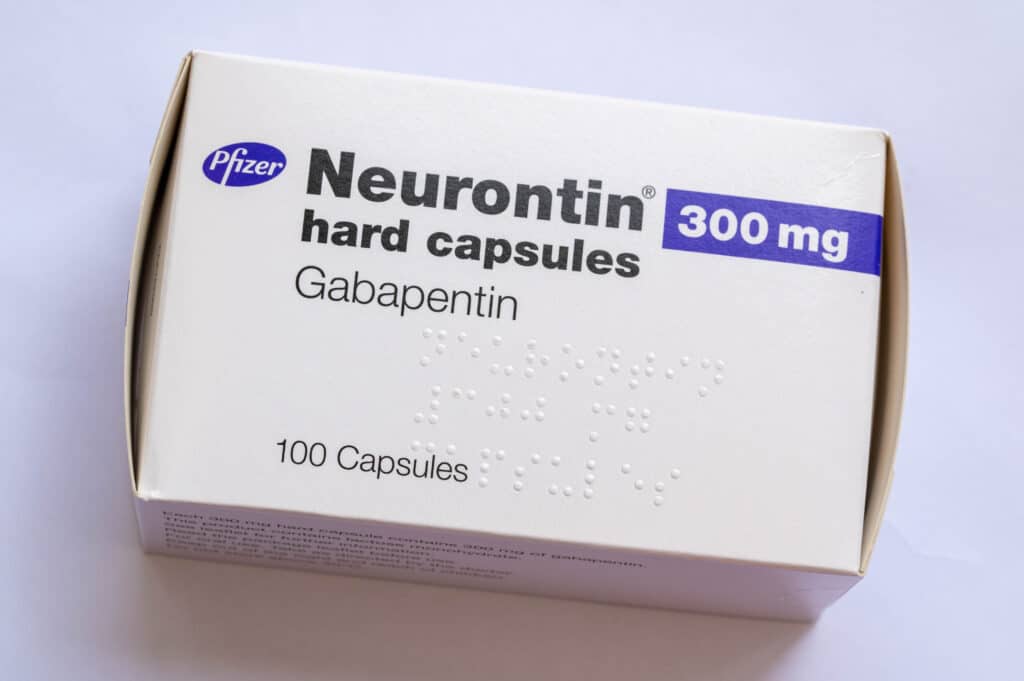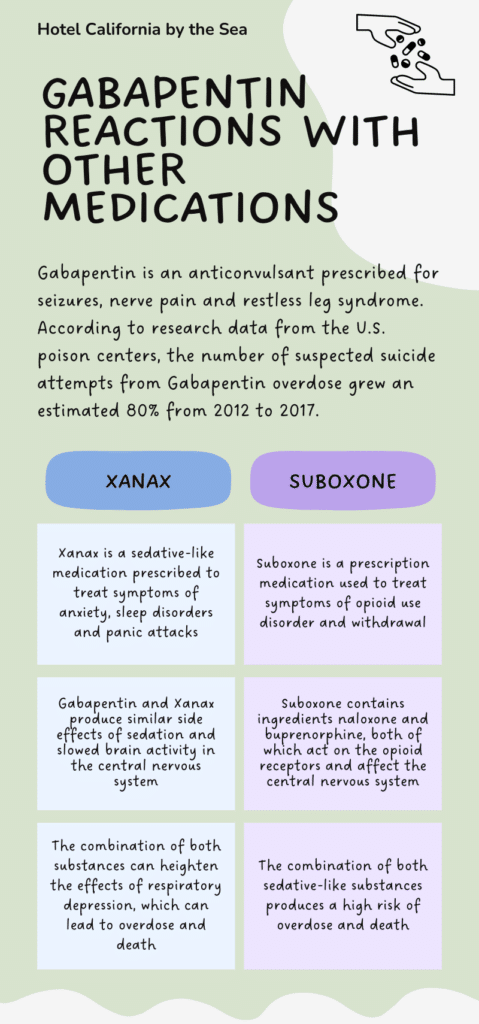Can I take Xanax with Gabapentin?
Gabapentin is an FDA-approved medication under a class of substances called anticonvulsants. It is often prescribed to treat seizures (from epilepsy), nerve pain or damage (from shingles or diabetes) and restless leg syndrome. Although not considered a narcotic or controlled substance in the eyes of the federal government, some states have begun classifying Gabapentin as a Schedule V Controlled Substance due to its high potential for abuse. Abuse and addiction increase when Gabapentin is used in conjunction with other mind-altering substances such as Xanax and Suboxone.

The drug is a gamma-aminobutyric acid (GABA) analog. It changes the brain chemistry by turning off stimulating alpha receptors. This lowers abnormal excitement in the brain, causes sedation and even respiratory depression. When misused, Gabapentin can alter the transmission of pain signals and how the body senses and processes feelings of pain. It often produces depressant-like effects on the central nervous system and can lead to symptoms such as drowsiness, dizziness, tiredness and weakness. Other side effects of Gabapentin misuse include:
- Fever and nausea
- Difficulty speaking
- Recurring infections
- Memory loss
- Weight gain
- Movement impairment
- Coordination impairment
- Blurred vision
- Thought of suicide and attempts to commit suicide
- Anxiety and panic attacks
- Restlessness
- Anger, aggressive and violent behavior
- Emotional changes
Gabapentin is also known as the brand names Neurontin, Gralise and Horizant. It is considered the first choice treatment option for medical conditions such as neuropathic pain and epileptic seizures. Because of its sedative side effects that can produce feelings of euphoria, it has led many to misuse the medication and lead to dependency and addiction. According to research data from the U.S. poison centers, the number of suspected suicide attempts from Gabapentin overdose grew an estimated 80% from 2012 to 2017.
Approved by the FDA in 1993, Gabapentin comes in various formats such as capsules, tablets and other oral solutions. Since then, physicians have also found other “off-label” uses for treating a variety of other conditions and disorders not associated with seizures. These alternative uses of the drug are not FDA-approved.
- Treating hot flashes
- Treating restless leg syndrome
- Treating neuropathic pain
- Treating symptoms of bipolar disorder
- Treating insomnia and anxiety
- Treating symptoms of alcohol withdrawal
- Treating symptoms of opioid withdrawal
- Treating symptoms of post-traumatic stress disorder

Can I take Xanax with Gabapentin?
Xanax is a sedative-like benzos medication prescribed to treat symptoms of anxiety, sleeping disorders and panic attacks. Because Xanax and Gabapentin share very similar side effects, the combination of the two drugs can lead to enhanced and worsening side effects for both. The drug interaction between the two heightens the effects of extreme sedation and respiratory depression.
The combination of the drugs can slow down brain activity to dangerously low levels with the potential for overdose. Other side effects include extreme drowsiness, physical motor impairment and slowed breathing. Xanax in itself has a high potential for misuse and addiction. When added with Gabapentin, the risks for addiction only increase. When both medications are taken separately and as prescribed, they can be safe with few to no interactions. However, when taken together, there is a heightened risk for dangerous side effects.
Can you take Gabapentin with Suboxone?
Suboxone is a prescription medication used to help treat opioid use disorder. It can help manage drug cravings and symptoms of withdrawal. Suboxone contains a mixture of the ingredients buprenorphine and naloxone. Buprenorphine partially activates the opioid receptors in the brain sending signals to the central nervous system to reduce cravings for opioids. Naloxone discourages the potential misuse of opioids by reversing symptoms of opioid overdose. It is the preferred treatment for treating opioid use disorders in combination with other therapeutic methods.
Gabapentin and Suboxone can have potentially dangerous interactions because both substances are central nervous system depressants. Symptoms of the combined drug combination include respiratory distress, extreme confusion, severe dizziness, extreme sleepiness, coma and death. Ultimately, the side effects for both Gabapentin and Suboxone are increased and intensified when taken together. This drug combination is not recommended due to its potential for addiction and overdose.
Check Your Insurance Coverage for FREE
Find out if your insurance covers addiction treatment in minutes. We accept most insurance!
Other drug interactions with Gabapentin
Some interactions with other substances and medications can worsen the side effects of Gabapentin. Other interactions can make Gabapentin less effective. Drug interactions should be taken into consideration when dealing with potentially addictive and high-risk prescription drugs. Opioids are a class of drugs that should be avoided when on Gabapentin. Like Gabapentin, opioids can cause similar side effects such as lethargy and slowed breathing. The combination of the two medications is likely to intensify the feelings of euphoria normally felt when taking opioids. In fact, opioids and Gabapentin had become such a well-known drug interaction, in 2019, the FDA put out a warning about the polysubstance use.
Research has found that the two medications can also significantly increase the risk of opioid-related overdose deaths. When used together, the sedative effects of both medications are intensified and increase the risk of respiratory depression, coma and even death. Signs of a Gabapentin-associated opioid overdose include:
- Trouble breathing
- Extreme lethargy
- Unconsciousness
- Cold and clammy skin
- Vomiting
- Lack of coordination
- Diarrhea
- Slurred speech
- Double vision
- Mental confusion and disorientation
- Extremely low heart rate or blood pressure
- Drowsiness and difficulty staying awake
- Ataxia (decreased muscle coordination)
- Hypoactivity
The interaction between Alcohol and Gabapentin can cause serious side effects. Alcohol can affect multiple organs in the body including the brain, kidney, liver and heart. It can influence mood, decrease alertness and slow down breathing. When in combination with Gabapentin, there is a higher risk of lethargy and sleepiness.
Antihistamines such as Claritin, Benadryl and Unisom are another class of medications that should be avoided when on Gabapentin. These groups of substances treat allergies and itching by blocking histamine in the body. Many of them produce side effects of sleepiness, decreased alertness and slowed breathing when interacting with Gabapentin.
Reach out to Hotel California by the Sea
We specialize in treating addiction and other co-occurring disorders, such as PTSD. Our Admissions specialists are available to walk you through the best options for treating your addiction.
Hotel California by the Sea provides premiere experience, support and evidence-based treatments to help clients with substance use disorders. Prescription medications such as Gabapentin, if misused, can become habit-forming and addictive. A Gabapentin addiction is most commonly found as part of polysubstance abuse in which it is misused in combination with other substances such as Xanax, Suboxone and alcohol.
The prescription drug treatment program offers multiple levels of care including drug detox, residential treatments, PHP and IOP programs. Detox ensures clients have fully and safely removed Gabapentin and other medications from their system in order to begin their journey of self-healing. Residential treatments allow clients to engage in rigorous therapies targeting any underlying mental health issues that may be contributing to their addiction. Outpatient programs such as PHP and IOP allow clients to continue therapies while preparing for independent life.
Evidenced-based treatments such as CBT, DBT and family therapy have been proven highly effective in helping clients through their sobriety journey. Addressing co-occurring mental health conditions helps clients understand the root cause of their disease and how they can overcome addiction. Hotel California by the Sea provides individualized treatment care for clients from across the nation.
References:
https://www.goodrx.com/gabapentin/interactions
https://www.confidanthealth.com/buprenorphine-suboxone-and-subutex/gabapentin-and-suboxone
https://www.workithealth.com/blog/the-interaction-between-suboxone-and-gabapentin/
https://my.clevelandclinic.org/health/drugs/21561-gabapentin
https://www.healthline.com/health/gabapentin-oral-capsule
https://www.psycom.net/mental-health-medications/gabapentin
https://www.addictioncenter.com/treatment/medications/suboxone/
https://www.medicalnewstoday.com/articles/323681#safety-and-risks
https://www.bicyclehealth.com/suboxone-faq/can-you-take-gabapentin-and-suboxone-together
